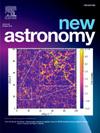首次对食双星英仙座V951的光度和动力学研究
IF 2.1
4区 物理与天体物理
Q2 ASTRONOMY & ASTROPHYSICS
引用次数: 0
摘要
本文利用新观测到的四色(B、V、Rc、Ic)光曲线和TESS数据,对短周期食双星英仙座V951(以下简称V951 Per)进行了研究。光度分析表明,该双星为w亚型浅接触双星,质量比为q = 1.95,接触度为f = 7.0%。为了很好地拟合不对称的光曲线,在质量较小的部分上使用了一个较冷的星斑。基于我们的新CCD日蚀时间和迄今为止公布的数据,用O−C方法分析了日蚀时间的变化。O−C图表明,V951 Per的轨道周期以dP/dt =−8.79 × 10−8 d yr−1的速率递减,叠加在一个振幅为0.0046 d、周期为11.4 yr的周期振荡上。周期的递减可以解释为质量较重组分向质量较轻组分的质量转移或角动量损失。这种循环振荡可以解释为光的传播时间效应,因为存在着看不见的第三个物体。我们计算出第三伴星的质量为M3sin(i) = 0.18 M⊙。本文章由计算机程序翻译,如有差异,请以英文原文为准。
The first photometric and dynamical study of the eclipsing binary star V951 Perseus
In this paper, we studied the short-period eclipsing binary V951 Perseus (hereafter V951 Per) using the newly observed four-color (, , , ) light curves and the TESS data. Photometric solutions suggest that it is a W-subtype shallow contact binary with a mass ratio of = 1.95 and a contact degree of = 7.0%. In order to fit the asymmetrical light curves well, a cool star-spot on the less massive component is employed. Based on our new CCD eclipsing times and the data published until now, changes in the eclipsing times were analyzed using the method. The diagram indicates that the orbital period of V951 Per is decreasing at a rate of = −8.79 × 10−8 d yr−1, superposed on a cyclic oscillation with an amplitude of 0.0046 d and a period of 11.4 yr. The secular period decrease can be explained by the mass transfer from the more massive component to the less massive one or by the angular momentum loss. The cyclic oscillation may be interpreted as the light-travel-time effect because of the presence of an unseen third body. We calculated the mass of the third companion as = 0.18 .
求助全文
通过发布文献求助,成功后即可免费获取论文全文。
去求助
来源期刊

New Astronomy
地学天文-天文与天体物理
CiteScore
4.00
自引率
10.00%
发文量
109
审稿时长
13.6 weeks
期刊介绍:
New Astronomy publishes articles in all fields of astronomy and astrophysics, with a particular focus on computational astronomy: mathematical and astronomy techniques and methodology, simulations, modelling and numerical results and computational techniques in instrumentation.
New Astronomy includes full length research articles and review articles. The journal covers solar, stellar, galactic and extragalactic astronomy and astrophysics. It reports on original research in all wavelength bands, ranging from radio to gamma-ray.
 求助内容:
求助内容: 应助结果提醒方式:
应助结果提醒方式:


